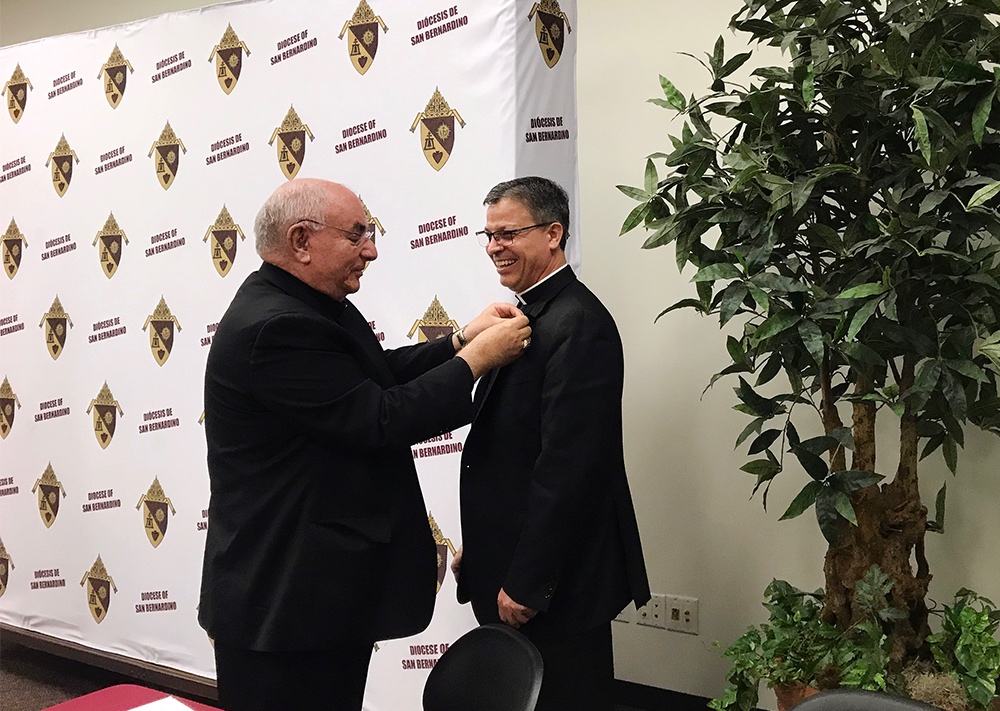San Bernardino, US
RNS
Bishop Alberto Rojas has been named to lead the Diocese of San Bernardino – one of the nation’s largest Roman Catholic dioceses – and will succeed Bishop Gerald Barnes, who plans to submit his resignation in June.
Pope Francis appointed Rojas, an auxiliary bishop from Chicago, to be coadjutor bishop of the Diocese of San Bernardino. As coadjutor, Rojas will assist Barnes in administering the diocese in the months leading to his retirement.

Bishop Gerald Barnes, left, places a pin with the words ‘Diocese of San Bernardino’ on Bishop Alberto Rojas, an auxiliary bishop of Chicago, who is set to lead the diocese after his anticipated retirement. PICTURE: Alejandra Molina/RNS
Under church law, Roman Catholic bishops are required to submit their letter of resignation to the pope on their 75th birthday. Once Pope Francis accepts Barnes’ resignation, Rojas will assume the role of bishop.
At a Monday press conference, Barnes — who has held his post for more than two decades – introduced Rojas as his successor. Rojas will be the third bishop of the Diocese of San Bernardino, which serves Riverside and San Bernardino counties.
Rojas, who was born in Aguascalientes, Mexico, said it was always his faith journey to become a priest and bishop. He addressed a crowd of diocesan leaders in English and Spanish during the announcement.
“All of you have so much to teach me,” he said.
Rojas praised Barnes, who has pushed the church to embrace immigration reform, for being a champion of immigrants. He said his father worked hard in the US and eventually gained residency for himself and his family.
“Even though I’ve lived most of my life in this country, I can easily identify with the experience of immigrants because I believe I am among them,” said Rojas, 54.
He hopes to follow in Barnes’ footsteps in advocating for immigrants.
“We will continue with that pastoral presence of the church…Looking for common ground and just immigration solutions,” he added.
Rojas will be taking over a diocese that has experienced significant growth in recent years. In 2014 the diocese reported 1.5 million Catholics, said John Andrews, spokesman for the diocese. Today it has grown to 1.7 million Catholics.
The region’s Catholic population is largely Latino, but Mass in the diocese has been celebrated in more than 10 languages, including English, Spanish, Tongan, Korean, Igbo and Indonesian. Priests have been white, Asian and Pacific Islander, Latino and black.
Barnes said he collected input from people across the diocese to hear what kind of bishop they would like as a leader. He said it was important for the diocese to have a pastoral person who was bilingual and “accepting of the diversity” of the area. Additionally, Barnes said he hoped his successor would be someone young who would be “open to the realities of the time, loyal to the church and inclusive of people.”
Rojas has spent much of his pastoral career in Chicago, where he was ordained a priest for the Archdiocese of Chicago in May, 1997, according to a news statement from the Vatican.
He studied for the priesthood at the Santa Maria de Guadalupe Seminary in Aguascalientes, Mexico, and at the University of Saint Mary of the Lake Seminary in Mundelein, Illinois, where he also served as a faculty member.
Rojas served as an associate pastor at St Gregory the Great and St Ita parishes between 1997 and 2002, according to the Archdiocese of Chicago. He has also served as a liaison to Hispanic Catholics and has been a member of the Hispanic Affairs Committee of the United States Conference of Catholic Bishops.
In 2011, he was appointed as an auxiliary bishop of Chicago.
At the press conference announcing his successor, Barnes stressed the importance of Rojas familiarizing himself with the nuances of the region.
The Inland Empire is made up of dozens of cities in San Bernardino and Riverside counties that span the tourist areas of Palm Springs and La Quinta to cities like Rialto and San Bernardino. It also includes desert areas like the Coachella Valley, where the diocese also ministers to indigenous communities.
“He comes from Illinois. It’s a different reality than California, in many ways,” Barnes said. “He comes from Chicago. It’s a major city in our country. We don’t have that here. We have many cities and each city has some kind of identity with the whole Inland Empire.”
Rojas does have local ties. He said he has a sister who lives in Los Angeles and is looking forward to exploring the area and getting to know its residents.
“I love nature. I love trees. I love mountains. In Chicago, I always missed them,” he said.
At his new post, Rojas said he aims to minister to the poor, the incarcerated and the youth. He said he looks forward to working with parishioners whom Barnes described as a faithful group with a “strong spirit of commitment.”
“I couldn’t ask for more,” Rojas said.






